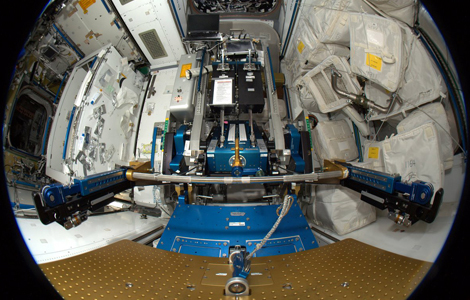The Beast
Weightlifting in weightlessness is now my favorite oxymoron.
Weightlifting in weightlessness is now my favorite oxymoron. (It has surpassed my previous favorite: reality TV.) Living in weightlessness causes our bodies to slowly degenerate, and for long-duration missions something has to be done to prevent, or at least mitigate, this degeneration. While the reasons are not fully understood, we have discovered an empirical solution, which also is not fully understood: an intense blend of cardiovascular and weightlifting exercises.
To accomplish the weightlifting—properly called resistive exercise—NASA has invented a machine that provides forces of up to 270 kilograms (600 pounds) that remarkably mimic the experience of weightlifting on Earth. When I finish a 1½-hour session on this machine, my muscles have been turned into salty limp noodles. (Heavy lifting also makes for heavy appetite. Here, I can truly claim to be able to eat my weight in barbeque). The weightlifting machine is called ARED, an acronym whose meaning I have long forgotten. I like to refer to this machine as The Beast.
When we lift weights under the influence of gravity, the force throughout the motion is constant. On Earth, we are used to this feeling. Normal weightlifting machines use springs, bows, bungees, or pneumatic cylinders to provide the load, with the resistive force increasing in proportion to the distance traveled. Most weightlifting machines rely on simple pulleys and weights, which of course do not work in weightlessness.
To make a resistive exercise machine for space that feels like lifting weights on Earth requires a different approach. It is possible to design springs that yield a constant force over a small displacement, but to make these operate over large motions, with user-selected loads that remain calibrated, leads to complicated mechanisms.
The invention in The Beast that solves the spring problem (giving force independent of displacement) uses something we have plenty of in space: vacuum. There are two large cylinders, with a vacuum behind each piston. The atmospheric pressure in the cabin pushes on the other side of the piston, thus creating a force independent of displacement (vacuum behind a piston does not “compress” like air does). Using a simple lever with a ball screw adjuster gives continuously variable, calibrated, and reproducible forces. These forces are transferred to a standard weightlifting bar through a yoke. When I stand on a platform attached to The Beast, the forces from my exercise are balanced within its structure, so that no unwanted vibrations are transferred to Space Station, which could spoil the environment for scientific experiments. The Beast is an engineering marvel that is central to maintaining crew health.
When living on a frontier, we move away from the standard way of doing things. The frontier spawns a class of invention that would never materialize if we remained comfortably surrounded by that which is familiar.
/https://tf-cmsv2-smithsonianmag-media.s3.amazonaws.com/accounts/headshot/Pettit_in_Star_City.JPG)

/https://tf-cmsv2-smithsonianmag-media.s3.amazonaws.com/accounts/headshot/Pettit_in_Star_City.JPG)